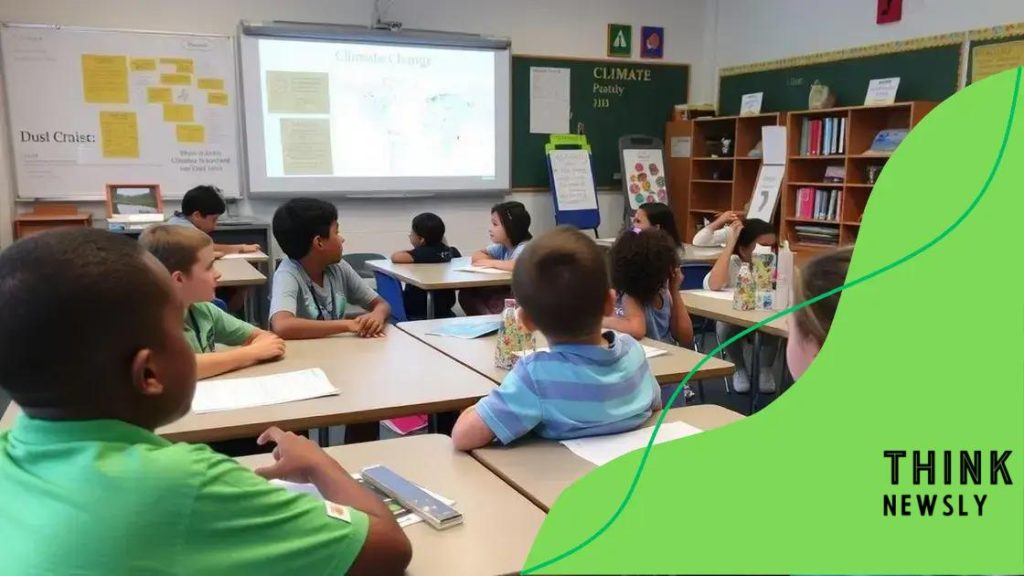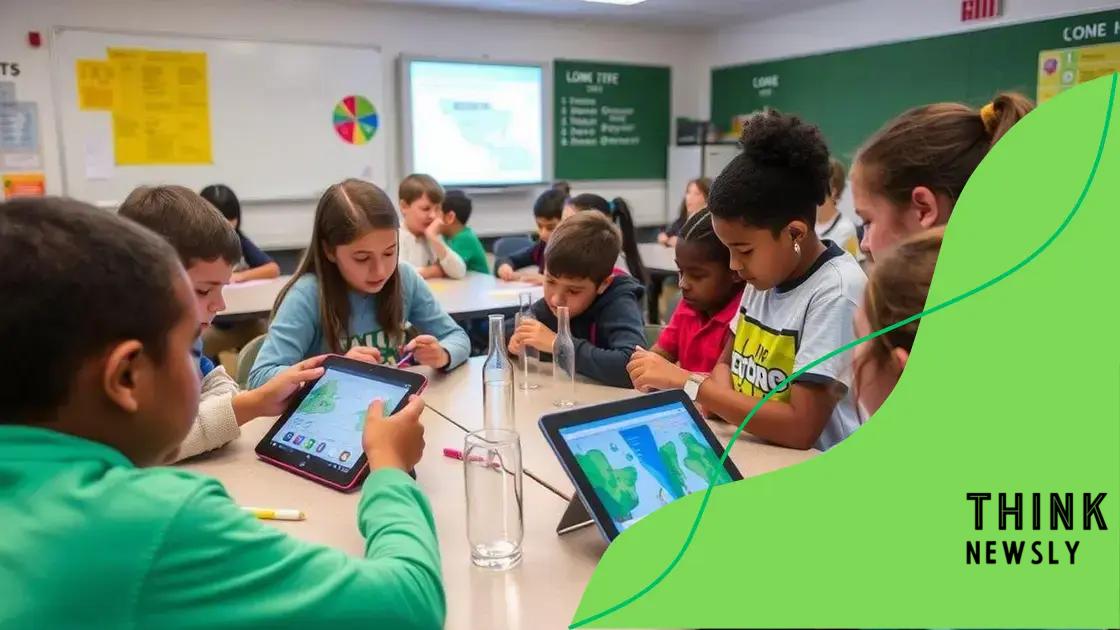Schools add climate crisis education to curricula

Anúncios
Schools add climate crisis education to prepare students for environmental challenges, fostering awareness and action through interactive learning, community involvement, and an updated curriculum focused on sustainability.
Schools add climate crisis education as a crucial step in preparing young minds for future challenges. But how will this shape their understanding and actions towards our planet? Let’s explore.
Anúncios
Understanding the climate crisis and its impact
Understanding the climate crisis is fundamental for today’s students. It’s not just a distant problem; it affects their lives now and in the future. They need to grasp how climate change is altering ecosystems and weather patterns.
What Causes Climate Change?
Several key factors contribute to the ongoing climate crisis. These include:
- Greenhouse gases: Emissions from cars and factories trap heat in the atmosphere.
- Deforestation: Trees absorb CO2, and cutting them down reduces this critical effect.
- Industrial activity: Manufacturing processes often release harmful pollutants.
- Fossil fuels: Burning oil, coal, and gas is a primary source of energy but has serious negative impacts.
By recognizing these causes, students can start to see the part they play. Simple actions can have a big impact. When students learn the facts, they begin to understand their role as future leaders. This understanding fosters a sense of responsibility towards the environment.
Anúncios
Effects of Climate Change
The effects of climate change are profound and wide-reaching. They include rising sea levels, extreme weather events, and loss of biodiversity. For instance, coastal cities might face flooding, leading to displacement. Changing weather patterns can also disrupt agriculture, threatening food security.
Furthermore, the climate crisis can lead to health issues. Air quality might decline, causing respiratory problems. Education about these impacts encourages young people to advocate for solutions.
Bringing awareness into schools is essential. It creates informed citizens ready to take action in their communities. Understanding the climate crisis equips students to make choices that benefit the planet.
Integrating climate crisis topics across subjects
Integrating climate crisis topics across different subjects is essential for holistic education. This approach not only enriches the curriculum but also shows students the interconnectedness of environmental issues.
How Different Subjects Can Incorporate Climate Education
Many subjects can include lessons on the climate crisis. This integration helps students understand how various fields relate to environmental challenges. For example:
- Science: Students can study ecosystems and the impact of pollution.
- Mathematics: Analyze data on climate change trends and emissions.
- Social Studies: Discuss the social and economic effects of environmental policies.
- Art: Create projects that raise awareness about sustainability.
By weaving climate topics into everyday subjects, students can apply their knowledge to real-world situations. This keeps them engaged and aware of pressing issues around them.
Benefits of an Integrated Curriculum
An integrated curriculum promotes critical thinking and problem-solving skills. When students tackle climate issues from multiple angles, they learn to view problems comprehensively. They develop a sense of ownership and responsibility towards the environment.
Additionally, climate crisis discussions encourage collaboration among students. They work together, sharing their ideas and solutions, which fosters a sense of community. This collaborative effort can inspire innovative thinking.
Moreover, integrating these important topics helps students feel prepared to face future challenges. They become advocates for change, equipped with knowledge and skills. Schools play a crucial role in shaping informed citizens ready to take action for a sustainable future.
Engaging students through interactive methods

Engaging students through interactive methods is vital in bringing the climate crisis education to life. Interactive learning helps students connect with environmental issues on a personal level, making the subject matter more relevant and exciting.
Ways to Involve Students
There are various techniques teachers can use to engage students effectively. Here are some engaging methods:
- Hands-on experiments: Conduct experiments that demonstrate environmental concepts, like measuring carbon dioxide levels.
- Field trips: Visiting local parks or conservation areas can provide real-world insights into ecosystems.
- Project-based learning: Assign projects that require students to come up with solutions for reducing their carbon footprint.
- Role-playing exercises: Allow students to take on roles of different stakeholders in climate action, such as a scientist, politician, or activist.
These methods promote creativity and critical thinking. When students participate in discussions and activities, they explore ideas together. This sense of collaboration enhances their learning experience and builds teamwork.
Using Technology in Climate Education
Incorporating technology into lessons can also enhance student engagement. Tools like interactive simulation games or apps that track carbon footprints are excellent resources. Students can learn while having fun, keeping them motivated.
Online platforms can facilitate discussions and allow students to share their ideas and projects with peers. This creates a broader community focused on climate action. Students can connect globally, learning from others’ experiences.
Furthermore, interactive methods make it easier for students to grasp complex issues surrounding the climate crisis. By making learning enjoyable, teachers not only keep students interested but also inspire them to advocate for change.
Local initiatives to support climate education
Local initiatives to support climate education play a crucial role in promoting environmental awareness among students. These programs often create community involvement, allowing students to connect with their surroundings while learning about the climate crisis.
Community Programs and Workshops
Many communities offer programs that educate students on climate issues through hands-on activities. These initiatives can include:
- Workshops: Engaging sessions on topics like recycling, conservation, and renewable energy.
- Community gardens: Teach students about sustainable agriculture and the importance of local food systems.
- Environmental clubs: Provide students a platform to discuss and work on climate-related projects.
- Clean-up events: Involve students in local efforts to clean parks or beaches, fostering a sense of community responsibility.
Participating in these activities encourages students to become active learners and change agents in their communities. They gain practical skills and knowledge they can apply in real-world situations.
Partnerships with Local Organizations
Schools can collaborate with local organizations to strengthen their climate education efforts. Partnerships with environmental nonprofits or government agencies often bring additional resources and expertise.
These collaborations may include guest speakers, educational materials, and support for larger projects. When students see local leaders and experts engaged in climate action, it inspires them to follow suit. Working together, schools and organizations can create more impactful experiences and broaden the reach of their educational initiatives.
Additionally, local initiatives help students develop a deep connection with their environment. They learn the importance of stewardship and responsible citizenship. With support from their communities, students can advocate for sustainable practices that positively impact the world around them.
Future of education in a changing climate
The future of education in a changing climate is becoming increasingly important as we face environmental challenges. Schools must adapt to prepare students for a world where the climate crisis is a central issue.
Integrating Climate Issues in Curriculum
Curriculums will likely evolve to include more content focused on the climate crisis. This might involve:
- Project-based learning: Encouraging students to develop solutions for local environmental issues.
- Interdisciplinary studies: Combining science, social studies, and economics to give students a comprehensive view of climate impacts.
- Technology use: Incorporating digital tools for simulations and data analysis related to climate change.
- Emphasis on sustainability: Teaching students about renewable energy, waste reduction, and conservation practices.
By integrating these elements, educators can help students become informed citizens who are ready to take action. Education will not just be about knowledge; it will emphasize the importance of critical thinking and problem-solving.
Preparing for Climate Resilience
Future education will also focus on building resilience in communities. Schools will play a key role by:
Preparing students to adapt to climate challenges, emphasizing emergency preparedness, and teaching about the impacts of natural disasters. Students will learn about recovery strategies and how to support their communities during crises.
Additionally, fostering partnerships with local governments and organizations will strengthen educational initiatives. By working together, schools can address climate issues more effectively.
As the climate crisis continues to affect our lives, education must evolve to reflect this reality. By focusing on sustainability and resilience, schools can empower future generations to lead the way in creating a healthier planet.
FAQ – Frequently Asked Questions about Climate Crisis Education
Why is climate crisis education important for students?
Climate crisis education helps students understand environmental issues and their impact, empowering them to take action for a sustainable future.
How can schools engage students in climate education?
Schools can use interactive methods like hands-on activities, local initiatives, and technology integration to make climate education engaging and relevant.
What role do local initiatives play in climate education?
Local initiatives provide practical learning opportunities and community involvement, helping students connect their education to real-world climate issues.
How will the future of education change regarding climate challenges?
The future of education will focus on integrating climate issues into curricula, preparing students to tackle environmental challenges through critical thinking and problem-solving.





